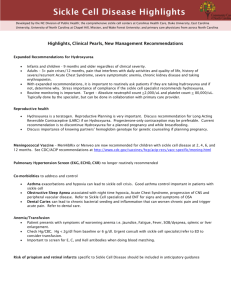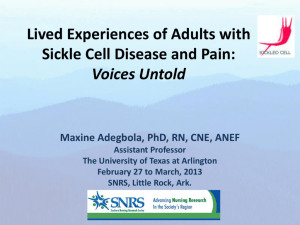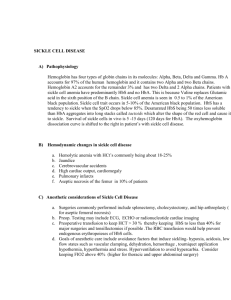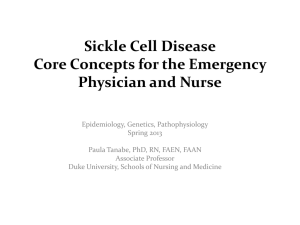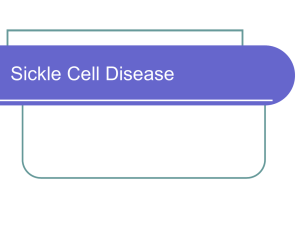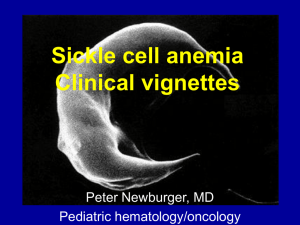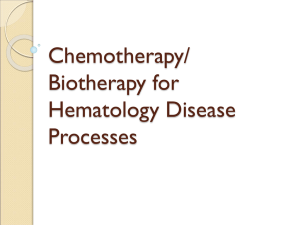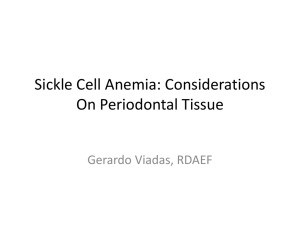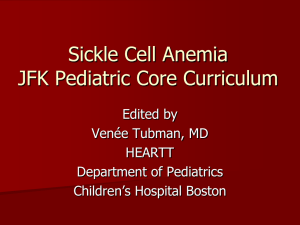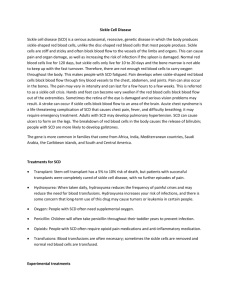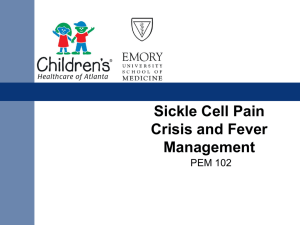Sickle Cell Disease: New Approaches and Guidelines
advertisement
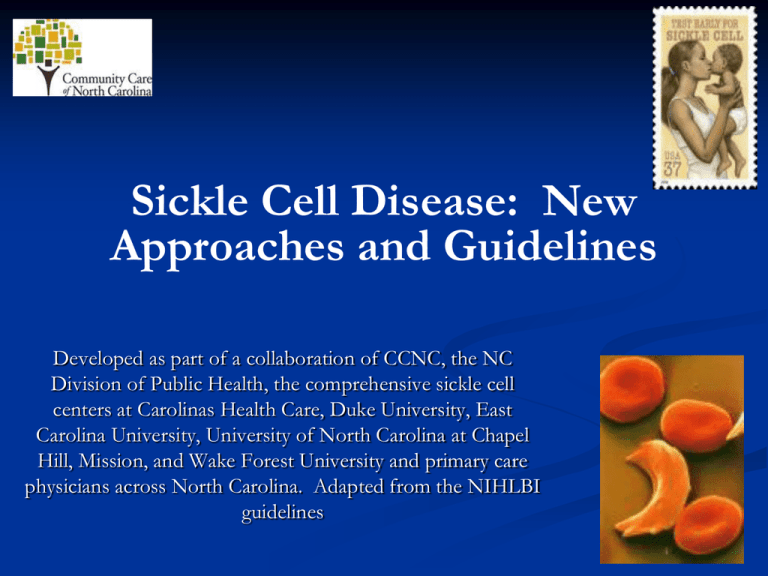
Sickle Cell Disease: New Approaches and Guidelines Developed as part of a collaboration of CCNC, the NC Division of Public Health, the comprehensive sickle cell centers at Carolinas Health Care, Duke University, East Carolina University, University of North Carolina at Chapel Hill, Mission, and Wake Forest University and primary care physicians across North Carolina. Adapted from the NIHLBI guidelines Objectives Provide basic overview of Sickle Cell Disease Understand recommendations for care based on 2014 NHLBI guidelines Health Maintenance Acute Problems Introduce tools to facilitate adoption of recommendations Foster specialist and primary care collaboration in care of patients with sickle cell disease Sickle Cell Disease (SCD) SCD refers to a group of disorders characterized by a predominance of HbS SCD affects 1 in 375 African American live births, as well as other populations Includes HbSS, HbSC, HbS/b thalassemia (b0b+), HbS/Other Sickle Cell Anemia (SCA) Subset of genotypes with often more clinical severity and anemia Includes HbSS, HbS/b0thalassemia Brief Pathophysiology Mutation at sixth position of beta globin chain changes glu → val With deoxygenation, the HbS molecule polymerizes within the RBC leading to characteristic shape changes Sickled erythrocytes are rigid and obstruct small blood vessels leading to tissue ischemia Deformed sickle cells adhere to endothelium & macrophages induces hemolytic process Inflammation and ongoing adhesion Manifestations of Sickle Cell Disease Chronic anemia Hemolysis Jaundice Cholelithiasis (bilirubinate) Acute complications Pain, priapism, stroke Acute chest syndrome (ACS) Splenic sequestration infection Chronic organ damage Spleen, brain Kidneys, lung, bones, eyes pulmonary HTN gallstones anemia Hemolysis leg ulcers nephropathy AVN Vaso-Occlusion asplenia ACS stroke pain Recommendations and Tools Health Maintenance Pediatric and Adult Problem-focused– Acute and Chronic Fever Respiratory Symptoms/Hypoxia Anemia Neurological Pain Tip Sheet - New Recommendations and Clinical Pearls Health Maintenance Routine Health Maintenance General co-morbidities to address and control Asthma Obstructive Sleep Apnea Dental Caries Screen for retinopathy/retinal infarct By history (age 0-2 yrs) By vision screen (3-10yrs) By comprehensive eye exam (10 yrs+) Screen for renal disease Proteinuria starting age 10y Routine Health Maintenance Screen for CNS problems (strokes, moyamoya) Annual Trans-Cranial Doppler (2-16y) for HbSS/HbSb0 By specialist History of neurocognitive symptoms/decline (headaches, changes in school or work performance) No longer routine Pulmonary Hypertension Screen (EKG, ECHO, CXR) Anticipatory guidance to include risk of priapism Routine Health Maintenance PenVK 125mg BID <3y; 250mg BID >3y Until age 5 yrs for HbSS/Sb0, if no splenectomy or invasive bacterial infection Typically to age 3 yrs for other genotypes, but weak recommendation to consider no prophylaxis 13-valent pneumococcal vaccine (Prevnar) as per recommendations for general population 23-valent pneumococcal age 2 and 7 years MenHibRix or Menveo at 2, 4, 6, and 12-15 months MCV4/Menactra – 2 dose primer at age 2, booster at age 5, and then every 5 years Routine Health Maintenance Hydroxyurea (HU) Original use – anti-cancer drug Increases fetal hemoglobin in the blood Prevents sickling of red cells RBCs survive longer in the bloodstream Daily doses reduce: Frequency of painful crises Frequency of acute chest syndrome Need for blood transfusions/severe anemia Mortality Effects of Hydroxyurea in SCA Expanded Recommendations for Hydroxyurea ALL children > 9 months with SCA (HbSS, HbSb0thal) Adults with SCA: 3+ painful crises in 12 months Sickle cell pain or severe symptomatic chronic anemia that interferes with daily activities or quality of life History of ACS Consider in other populations (e.g. SCD and chronic kidney disease, HbSβ+thal/HbSC and recurrent painful crises) Initiation and Monitoring Starting dose Children - 20 mg/kg/day Adults - 15 mg/kd/day (5-10 mg/kg/day if CKD) Increase by 5 mg/kg/day q8w to maximal tolerated dose (max 30-35 mg/kg/day) Monitor CBC, reticulocyte count every 4 weeks during initiation and every 3 months while on a stable dose Maximum tolerated dose to keep ANC >2,000/µL– 4,000/µL Platelets >80,000 ARC >80,000 Initiation and Monitoring Initiation and titrating typically done by specialist Monitoring could be done in collaboration with PCP, if more accessible for the patient Similar to anti-convulsant levels and titrating Reproductive Counseling Discuss importance of knowing partners’ hemoglobin genotype for genetic counseling Hydroxyurea (HU) is a teratogen Long Acting Reversible Contraceptive (LARC) is recommended while on HU Progesterone-only contraception may be preferable Current recommendation is to discontinue HU before pregnancy and while breastfeeding Acute and Chronic Problems Fever Respiratory Symptoms Anemia Neurological Symptoms Pain Management of Fever in SCD Prompt evaluation for any fever > 38.5°C (101.3°F) Age < 1 year (any fever > 38°C (100.5°F) CBC, Blood Culture, retic, ± CXR ± Ucx Immediate administration of IV/IM Ceftriaxone Recommend hospital admission for: Age < 1 year Temp > 39.5°C, 103.1°F Allergy to Cephalosporins Surgical splenectomy/history of pneumococcal sepsis Unsure follow-up Toxic appearance, low BP Infiltrate on CXR WBC < 2000, > 30,000 x 109/L Hb < 2 g/dl from baseline or < 6g/dl Respiratory Symptoms Biggest worry-Acute Chest Syndrome Number One cause of death Any new infiltrate with clinical symptoms (e.g. fever, dyspnea, chest pain, hypoxia, increased WBC) CXR may be negative in first 24 hours Lower lobes most commonly involved; 1/3 bilateral May be caused by infection, sickling, fat embolism, atelectasis Neurological Symptoms Acute focal neurological deficits Risk of acute stroke Immediate, emergency evaluation and treatment Headaches Risk of Moyamoya - Stenotic arteries in Circle of Willis/basal ganglia with network of collaterals (“puff of smoke”) Referral to specialist Neurological Symptoms “Silent” Cerebral Infarcts Cerebral ischemia on MRI without focal neurological symptoms 20-30% patients with HbSS Associated with neurocognitive deficits/decline Increased risk of overt stroke Progression shown to be decreased with chronic transfusion therapy Consider referrals for neuro/neuropsych/sickle cell specialist/learning eval/IEP Pegelow Blood, 2002; Kwiatkowski BJH 2009; DeBaun Blood, 2012 Pain Acute Chronic Acute Painful/ Vaso-occlusive ‘crisis’ Most prominent manifestation Variable frequency (none to daily) May be precipitated by illnesses, stress, dehydration Pain in the extremities, Headache, Chest, Abdomen Abdominal pain may mimic surgical condition Acute/Vaso-occlusive Assess for other complications (e.g. aplastic crisis, neuro event, priapism, sepsis, fever, ACSD, abdominal, ortho, etc) Keep warm, hydrated Assure following home pain plan Home plan fails → emergency treatment Chronic Pain Major Causes – Avascular necrosis of hips/shoulders, leg ulcers, chronic bony pain, priapism, neuropathic pain/hyperalgesia Assess effect on activity, functional status, quality of life, depression Involve pain management specialist, sickle cell provider, ortho as indicated Controlled, coordinated pain management Best if one provider manages chronic pain medications Pain Agreement Check CSRS/Provider Portal for medication/prescriber history Thank you Acknowledgment for part of slide content: Jennifer Rothman, MD Director, Pediatric Comprehensive Sickle Cell Program, Duke University Medical Center
